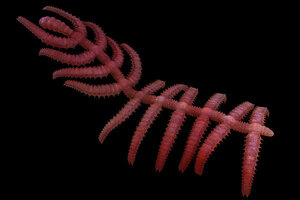Walking cactus discovered in China
Walking cactus: Scientists have discovered what researchers are calling the missing link in China. The strange-looking walking cactus is thought to be the link between worm-like creatures and arthropods like spiders.

Walking cactus: An illustration showing the walking cactus; the missing link between lobopodians and arthropods.
Jianni Liu/AFP/Newscom
Fossils of a 10-legged wormy creature that lived 520 million years ago may fill an important gap in the history of the evolution of insects, spiders and crustaceans.
The so-called walking cactus belongs to a group of extinct worm-like creatures called lobopodians that are thought to have given rise to arthropods. Spiders and other arthropods have segmented bodies and jointed limbs covered in a hardened shell.
Before the discovery of the walking cactus, Diania cactiformis, all lobopodian remains had soft bodies and soft limbs, said Jianni Liu, the lead researcher who is affiliated with Northwest University in China and Freie University in Germany.
"Walking cactus is very important because it is sort of a missing link from lobopodians to arthropods," Liu told LiveScience. "Scientists have always suspected that arthropods evolved from somewhere amongst lobopodians, but until now we didn't have a single fossil you could point at and say that is the first one with jointed legs. And this is what walking cactus shows." [Image of walking cactus fossil]
Leggy find
Liu and other researchers described the extinct creature based on three complete fossils and 30 partial ones discovered in Yunnan Province in southern China. The walking cactus had a body divided into nine segments with 10 pairs of hardened, jointed legs, and it measured about 2.4 inches (6 centimeters) long.
It's not clear how the leggy worm made its living. It could have used its tube-like mouth called a proboscis to suck tiny things from the mud, or it may have used its spiny front legs to grab prey, Liu said.
Clues to arthropod evolution are preserved in modern-day velvet worms, which are considered the only living relative to all arthropods. Once mistaken for slugs, these land-dwelling worms are almost entirely soft-bodied except for hardened claws and jaws.
Where spiders, insects and others came from
The discovery of the walking cactus helps fill in the evolutionary history between the velvet worms and modern arthropods, which, in terms of numbers and diversity, are the most dominant group of animals on the planet, according to Graham Budd, a professor of paleobiology at Uppsala University in Sweden, who was not involved in the current study.
The walking cactus is the first and only case of hardened, jointed limbs built for walking appearing in a creature that is not recognizable as an arthropod, Budd said.
But Budd is not convinced that, as the researchers argue, the walking cactus's hardened legs were passed directly down to modern arthropods.
"I am not persuaded that it is a direct ancestor or as closely related to living arthropods as they suggest," he told LiveScience. "I would like to see more evidence; the great thing is a lot more material keeps coming up."
For instance, it is possible that the walking cactus is less closely related to modern arthropods, and that hardened legs evolved multiple times. It is also possible that the bodies of primitive arthropods hardened before their legs did, Budd said.
New fossils, particularly from China, have helped clarify the evolutionary history of arthropods, and in the last decade or so, scientists have come to more consensus regarding that history, he added.
You can follow LiveScience writer Wynne Parry on Twitter @Wynne_Parry.
